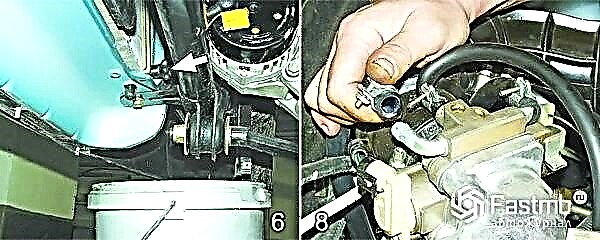Find out how to properly change the coolant on a VAZ 2110 car. Step-by-step instructions and photo support.

Tips before changing the coolant
- When starting to independently replace the fluid in the engine cooling system, you need to know that it can only be drained from a cooled engine.
- Any coolant is a chemical that can harm the human body, so you should never drink it, inhale its vapors, or allow it to splash in the eyes, or even on the skin. It is better to do everything with gloves and slowly.
- If antifreeze was topped up, then you can start the car only after the expansion tank cap is screwed back into place.
How many liters of coolant do you need in a VAZ 2110? It will take about 8-9 liters. According to the regulations, the coolant must be changed every 5 years of vehicle operation or every 70 thousand km. mileage, but as practice shows, many drivers on the VAZ 2110 make a replacement every two years.
Replacing the coolant on a VAZ car
Replacing the coolant in the engine of a VAZ 2110 or 2111 car is actually quite simple. You just need to adhere to the order of performing this operation:
1. You should try to put the car as evenly as possible. If there is no horizontally located platform nearby, then the front of the car should be positioned higher than its rear.
2. Before starting work, the machine must be de-energized. To do this, simply disconnect the negative cable from the battery.
3. As is often the case with the "creations" of AvtoVAZ, in order to get to one part, you have to remove another. In our case, in order to drain the fluid from the cylinder block, it will be necessary to dismantle the ignition module with the bracket.

4. To create pressure in the cooling system, which will accelerate the outflow of the drained liquid, you need to open the expansion tank by removing the plug.
5. Having gained access to the drain plug of the fluid from the motor block, you should unscrew it, after placing a certain container under the engine. Draining the coolant should be done carefully in order to prevent spillage of this chemical composition around the vehicle. After completing the operation, wipe the plug and drain hole with a clean cloth.

6. The next step will be to drain the liquid from the radiator, so the container needs to be moved under the radiator. The procedure is similar to draining the liquid from the block: you need to remove the plug and let the liquid drain into the container.
7. After the cooling system of the car is empty, the plugs of the block and radiator must be screwed to their rightful place.
8. If we are talking about an engine with a fuel injection system, then it will be necessary to disconnect the clamp and dismantle the hose that supplies the antifreeze at the point of its connection with the throttle pipe heating fitting.

9. If the coolant is drained from the carburetor motor, then the hose should be unscrewed from its connection with the carburetor heating fitting. These actions will avoid the formation of the notorious air congestion, which in the future will prevent the liquid from filling the system evenly. It is through the hole formed as a result of disconnecting the hose from the heating fitting that the air displaced by the liquid poured into the system will come out.
10. Then the actual filling of the system with coolant takes place. It must be poured into the expansion tank until its level is level with the upper edge of the fastening strap that holds this tank. After that, the expansion tank plug is screwed into place.
11. The hose, which we unscrewed before pouring the liquid, is returned to its place, screwing it to the heating fitting.
12. After that, you need to return to the place removed to gain access to the drain plug
fluid from the cylinder block ignition module.
13. We connect the "mass" to the battery.
14. After that, you can start the engine and warm it up to operating temperature. Sometimes warming up helps to push through the formed air locks, after which the liquid leaves the tank. If this happens, you need to turn off the machine and add coolant to the desired level.
Very often inexperienced drivers "boil" the engine, allowing the engine to overheat. This happens if, when driving in low gear, the cooling fan activation system does not work. If the driver monitors the engine temperature gauge while driving, he will notice that the arrow of this device has gone into the red zone. This signals danger, which means that emergency measures need to be taken.
Despite the possible heat outside and in the cabin itself, you need to immediately turn on the "stove". If it blows hot from the heater, it means that the fan is out of order, and if it is cold, then the cause of overheating lies in the airlock mentioned above. In the first case, it is impossible to turn off the engine until the steam until the engine temperature drops due to the operation of the “stove”. In the second case, you can turn off, while you need, after waiting for the engine to cool, open the plug on the expansion tank. Then you need to again disconnect the same hose that was discussed in paragraphs 8 and 9 of our instructions and, adding liquid, achieve an air outlet.
WHA











